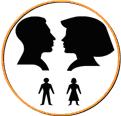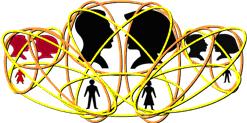Myths of the Meadow
by Don Partridge
Dating parents who are in the meadow, head over heels in love with one another, find themselves creating some powerful myths. Without even realizing it, as the intensity for one another increases, so also do some myths, growing powerfully alongside the relationship. And it is these myths that are most responsible for the problems and difficulties experienced when couples blend their families. As a result of the myths dating couples have little appreciation for the complexity of their future stepfamily. The myths stifle preparation and prevent couples from obtaining the knowledge and skills necessary to make a smooth running family. Ultimately, it is the myths that are largely responsible for the high number of stepfamily failures.
Here are some of these myths:
Myth 1: Stepfamilies and first marriage families are basically the same type of family. The myth accepts the fact that the stepfamily will be a bit more complicated but overall the myth concludes that the new family won’t be that much different than their previous first-marriage families. Allowing time for adjustment, the joined families should be pretty much like any other family.
Myth 2: Because of the first myth that stepfamilies and first marriage families are basically the same, the second myth naturally concludes that they operate and run about the same way. The parents, including stepparents, are the authority figures, the kids follow the parent/stepparent’s lead, everyone gets along well and things should run pretty smoothly.
Why These are Myths
Below are two families: the husband and wife and children on the left are in a first marriage; the husband and wife and children on the right are in what we call a blending family, or a stepfamily.

Both families appear identical. Just looking at them you would probably say that the two families seem to be quite similar. But here’s what a first marriage family really looks like:

The circle around everyone shows all the members share a one-of-a-kind relationship with one another. The parent are connected through a “one-flesh” relationship according to Genesis 2:24, “…the two shall be one flesh.” The children are biologically connected to both parents through birth.
What you are seeing are four individuals all uniquely joined together, sharing in an exclusive relationship with one another. Some fellow just can’t walk in and announce that he’s now dad. No woman is allowed to come in and declare herself mom. And no child is going to waltz into your home and suddenly share in the same privileges as your own children.
This connection between family members is exclusive. Outsiders are outsiders. We may like them, we may love them, but they are not part of our biological family. That’s why the family members are all within one circle. They’re all joined together. They are one. This is a simple, non-complex, family.
Divorce changes the family structure and divides the family into two parts. Below is what it looks like when the parents are no longer married. What was once one biological connection—all the family members together—there are now two, and here they are:

The parents no longer share a relationship. Yet, the children continue to have a biological connection with mom and dad, the children individually with their own father and mother. Even if one of the parents abandons the family, or dies, the children continue to recognize that individual as their biological parent. So what was once one connection we now find two.
Enter the dating parent. Here we see a dad with his son dating a mom with her daughter. The circles show the biological connections between the child and parent.

They get married. See the marriage connection, the added circle around the adults below?

So look what we have here: three independent, major connections among these four family members: the dad with his son, the mom with her daughter and the couple themselves.
And to complicate this stepfamily a bit more there are step-connections: The stepson and stepmother, the stepdaughter and stepfather, and among the kids themselves as stepbrothers and stepsisters. With the added step-connections there are now six major relationships. Just look at this:

In the first marriage everyone has the same connection between one another. But here, there are six separate connections. And each relationship requires specific training and understanding. You can’t go into this new family system with all these separate connections and imagine that this family is like a first marriage. The stepfamily is far more complex.
Now let me take away all the connections to make this next point easier:

Look at the children above. For the boy, we see his father but not his mother. If he has a father then he also has a mother out there somewhere. The same for the daughter, we see the mother but we don’t see her father. Let us say that the children’s other parents, who are not shown above, have also remarried to adults with children of their own. What does this family look like now? Here they are:

And let’s now put in all the various connections, both biological and the step connections:

Wow! Eighteen major individual connections overlapping with one another. And this is common for stepfamilies. Look at the complexity. What began with one relationship in a first marriage has evolved into a nest of merged and overlapping connections. Just look at this. And everyone one of these connections are critically important to the health and welfare of every individual you see up there. If a child has trouble with one parent or a stepparent or there is on-going war between parents, huge emotional damage can and will occur. Any one of these connections can quickly trouble the stepfamily.
What you see are adults and children in a system with high potential for conflict and difficulty. What you see are adults no longer having full control over their kids, their families, and even their own lives. See any problems with the biological connections overlapping the non-biological? We know that because of past divorces the former spouses are likely not working well together. And the added step-connections and forced relationships between children and adults produce major difficulties.
Most stepfamily don’t last and for some, they can’t last. Many adults just don’t have it within them to handle all these complex and interfering relationships. This doesn’t mean all stepfamilies have enormous difficulties, but what we’re looking at is a highly complex family system with the potential of major, and constant, difficulties. It’s like all these people playing football along the edge of a lion’s den. Play long enough and somebody’s going to fall in, with catastrophic results.
- What do you do when your stepchildren misbehave and the children’s parent will do nothing to correct the behavior? And your stepchildren’s misbehavior and their lack of control makes you feel like a prisoner in your own home?
- What do you do when your own spouse is too hard on your children but clearly shows favoritism to his or her own kids? And won’t change?
- What do you do when your stepchildren treat your own children badly, and the stepchildren have the approval of your spouse, the children’s parent?
- What do you do when your children’s other parent influences your children to hold in contempt your new spouse? And the other parent supports your children’s terrible behavior toward you and your spouse?
- What do you do when your stepchildren refuse to clean up after themselves, leaving the kitchen and family room a mess and their bedrooms and bathrooms are a nightmare? And your spouse is demanding that you ignore the behavior? But your own children are complaining that they are forced to clean up after these kids?
Here’s the first marriage family alongside the blending family. Look at the difference!


This is our point. There is no similarity to first marriages and stepfamilies, even if the stepfamily is not as complicated as the one shown above but only has four or five biological and step-connections. It still has the potential for major difficulties.
Stepfamilies are all about ex-spouses, ex-relatives, children moving back and forth between households, about caring for a family alone, about not being with your children when you want to. Dating a parent is not about dating a single individual, it’s about dating a crowd—you date the parent, the child, the relatives of that child, the other parent, the other parent’s new partner, and on and on. And when you remarry, it’s about another partner with completely new rules and traditions, living with non-biological family members, stepparent/stepchildren relationships, and far less control.
Apply the rules of a first marriage to the blending family and catastrophe will occur. The laws and rules and principles that work for first marriages don’t apply to blending families. Blending families live in another universe under an entirely different set of rules and principles that have nothing to do with first marriages and nothing to do with what is known and what is familiar.
Laws for first marriage families applied to stepfamilies will ruin a good family. Living in a stepfamily means living by new principles completely different from anything you have previously encountered.
The myths of the meadow desensitize the dating couple. The myths tell the couple that stepfamilies are basically the same as first marriages, operate about the same and that joining families will reduce the adult’s difficulties. And, since our marriage will last forever and our children will be happy and content, why prepare? We’re good!
Dating couples do not understand or realize they are entering into a family system that has unbelievable complexity and high failure rate, and for the families who do manage to remain together; few find the satisfaction they imagined. Diligent preparation is absolutely critical—a must—for the dating couple to realize their future dreams.
Let’s be clear, the stepfamily can be a highly profitable family system to pursue if the dating couple is committed to learning and the acquiring the specialized knowledge and skills to make stepfamilies work. For the prepared, the stepfamily could be a highly satisfying experience. But be warned. Without substantive preparation, the stepfamilies can be, and usually are, family systems filled disappointment and adversity.
For couples in the meadow however, buried in myth, there is no feeling of desperation, only dreams of pleasure and contentment; no feeling of need for preparation, only heady satisfaction; no feeling of anxiousness or apprehension, only pleasant anticipation; no unease, alarm, or foreboding; only future happiness and bliss. The meadow’s intoxicants and its myths have numbed the couple, numbed them from any sense of any need to pursue the help and information necessary to make for a smooth running stepfamily.
Next article in this series: Double Extreme Environments
Dr. Donald Partridge’s first marriage lasted thirteen years. Once divorced, and with two very young children, Don lived as a single parent with his children. Later Don remarried and has been in a highly successful stepfamily with seven children for the past 22 years.
Dr. Partridge has committed himself to working full time with single parents and stepfamilies and has written some very helpful books and pamphlets on how single parents can date and remarry successfully, how to build great stepparent/stepchild relationships, and how to insulate your children and raise them to be stable, emotionally healthy kids in the midst of calamity and shifting family systems. Available at www.blendingfamily.com